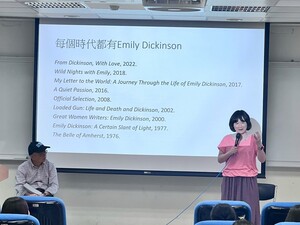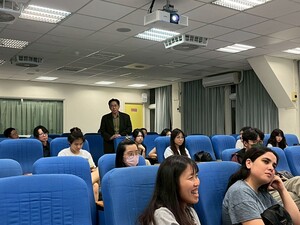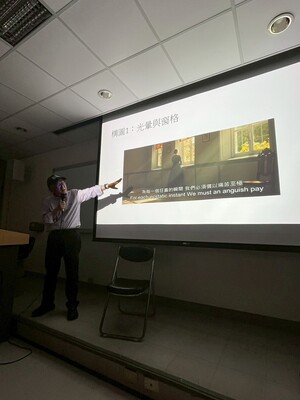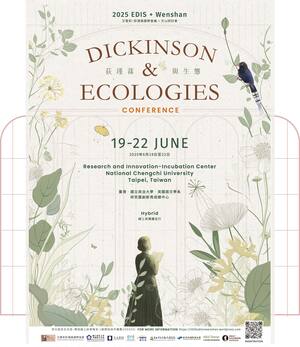Watching "A Quiet Passion" and Discussing the Enigmatic Life of the American Poet "Emily Dickinson"





【Article by Dept. of English】
This Wednesday, the College of Foreign Languages & Literature and the College of Communication hosted the second joint mentor activity of this semester. This activity invited Prof. Li-Hsin Hsu, the chair of the Department of English, and Prof. Ru-Shou Chen (Robert), the Chair of the International Master’s Program in Inter-Asia Cultural Studies, as the hosts to engage in an interdisciplinary discussion on the 2016 film A Quiet Passion by the British director Terence Davies.
A Quiet Passion was screened on campus on March 26. This biographical film, starring Cynthia Nixon, portrays the life of the renowned nineteenth-century American poet, Emily Dickinson. Historical accuracy aside, Davies captures Dickinson’s struggles with gender expectations, family bonds, as well as the social and religious complexity of her time through beautiful cinematography and dialogue. The film has been widely praised for its poetic storytelling, featuring 19 of Dickinson’s poems—all read thoughtfully by Nixon—offering a glimpse into the poet’s inner world and crucial moments in her life. With its impressive narrative approach, A Quiet Passion not only won the Grand Prix at the International Film Fest Gent in 2016 but, more importantly, invited the audience to reflect on art, solitude, and the passage of time.
Following the screening, Profs. Ru-Shou Chen and Li-Hsin Hsu shared their insights on the film, providing in-depth perspectives for the faculty and students who attended the activity.
Chen began by highlighting the uniqueness of Dickinson, noting that new biographical films about her continue to emerge over time. Like the film’s closing music, The Unanswered Question by Charles Ives, Dickinson’s life remains an enigma to different generations more than a century after her time. Chen also mentioned that director Davies may have resonated with Dickinson in their shared sense of loneliness. Due to his personal preference, he tended to focus on Dickinson as an isolated figure rather than her perceived lesbianism—a popular topic in current discussions about her life.
Chen later analyzed the film’s visual language from a cinematic perspective. He noted that the film opens with an unconventional shot reverse shot, which creates an atmosphere of confrontation and misplacement while simultaneously hinting at Dickinson’s uniqueness and her uncommon opinion about religion. He also discussed “the key three minutes,” which reveals the film’s most crucial theme. In A Quiet Passion, it occurs in a 360-degree shot inside Dickinson’s home: Davies uses the sound of bells, flattened visual space, and the characters’ tearing eyes to imply the passage of time and mortality. Moreover, Davies’s preference for window frames, indoor settings, and flat-space shots suggests Dickinson’s entrapment—her talent and spirit are confined by her family and society, leaving the poet constrained and unfulfilled.
As an expert in Emily Dickinson studies, Hsu said that she, along with many fellow scholars, found it difficult to enjoy A Quiet Passion since it lacks biographical accuracy. For instance, the friendship between Miss Buffum and Dickinson plays a significant role in the film in understanding Dickinson’s rebellion against social norms, but in reality, there is no such a person within the Dickinson circle. Also, the film claims that Dickinson died of Bright’s disease, a kidney ailment, while her exact cause of death remains uncertain because medical records at that time often assigned the same diagnosis to various different illnesses. Hsu explained that Dickinson is considered an enigma, even during her lifetime. The poems published during her lifetime were anonymous, and she asked her sister to burn all of her poems and letters after she died. Fortunately, her sister Lavinia preserved her poems and they were later published. Hsu also discussed Dickinson’s close relationship with Susan Gilbert Dickinson, her close friend and first reader, as well as Mabel Todd, an admirer of her poetry who later edited and compiled the first edition of her poems.
During the joint mentor activity, Hsu emphasized that Dickinson’s poems are often full of playfulness—a quality absent from the film and replaced often by the emphasis on her frustration and cynicism. As Chen suggested, this portrayal might stem from the projection of the director’s own social isolation onto Dickinson. However, for Hsu, such an interpretation limits the audience from appreciating Dickinson through multiple perspectives. This problem further raises an ongoing debate about adaptation: should a film adaptation be faithful to historical facts and the original texts, or can it be creatively reinterpreted—despite its inherent distortions? Hsu noted that because A Quiet Passion is a biopic, if the director takes liberty with their fabrication, the film may risk making such an autobiographical approach problematic. On the other hand, Chen referenced the idea of “the Death of the Author,” saying that the director has the privilege of shaping the film’s style and narrative as they see fit.
Inspired by the post-screening conversations between the two colleges, Professor Yae-Wei Wang from the Department of Radio and Television, along with many attending students, expressed enthusiasm for the continuation of similar interdisciplinary exchanges in the near future. While this semester’s joint mentor activity concluded on Wednesday, the English Department of National Chengchi University and the Emily Dickinson International Society (EDIS) will co-host the 2025 International Conference “Dickinson and Ecologies” from June 19 to 22 at the Research and Innovation-Incubation Center at NCCU. Faculty and students with an interest in Dickinson studies are cordially invited to participate.
